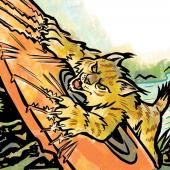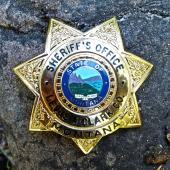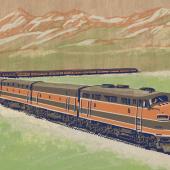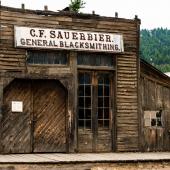The Tradition of Spring Branding Lives On

Photo by Todd Klassy
America is a different place than it was even 20 years ago. And while the engines of change continue to roll on, there are places right here in Montana where time moves just a little slower. And that’s not necessarily a bad thing.
Throw a rock from any house in the thickly settled parts of America and you would be hard-pressed not to hit a neighbor’s home. That’s how close many now live. The average person in rural Montana would likely consider such living conditions hard to fathom. But more shocking is the fact few even know who their neighbor is. That is not at all the case on most ranches in Montana today.
Though “neighbors” often live many miles apart, ranchers here almost always know those who live near them. Though fiercely independent, ranchers still often rely on neighbors for assistance from time to time. This is especially true in the spring when friends, family and neighbors gather on ranches to help round up the cattle and participate in the annual rite of passage known as branding.
Yes, some unfamiliar with ranching might think branding is just another mundane, labor-intensive task. Still others wonder why the practice still happens at all. With advances in computer technology, radio frequency identification (RFID), and drones, those still familiar with the job might consider it a relic of the past and something only seen in fanciful portrayals of the West, such as Paramount Network’s “Yellowstone.” Hugely popular television shows and movies have made cowboy culture popular again, but branding is more than just a passing fancy found in Hollywood scripts. In Montana, it is tradition. And it is still required by law in almost every Western state.
Branding cattle is probably best compared to an Amish barn-raising, where neighbors gather together to raise a wooden barn in just one day. A similar approach to getting a job done occurs on many ranches in Montana when neighbors help each other brand many hundreds of calves in a single day. Every ranch brands cattle at least once every year, but they brand almost every weekend in the spring as they also chip in to help those who live around them. It is an effort that traditionally requires the help of an entire community of individuals working together.
Ranchers use hot branding irons to affix their brand and proof of ownership to every head of cattle. Doing this prevents cattle from getting mixed into a neighbor’s herd. It also prevents theft, which, believe it or not, still happens today.

Photo by Todd Klassy
Branding typically occurs in Montana every weekend in April and May…and occasionally June, too. The rare exception (though not entirely) is Mother’s Day. Even cowboys have mothers.
Early in the morning, just as the spring sun rises in the east, the prairie starts to come to life. Meadowlarks, prairie chickens and other birds provide the soundtrack of the grassy plains, which is only interrupted when the rounding up of cattle begins. Roads that seldom see much traffic on other days suddenly come to life as dozens of ranchers and helpers pull trailers with their pickup trucks (a.k.a. outfits) down these lonely gravel roads. Their destination is often the middle of a large wide-open pasture that is largely empty, but for the grass, cattle, and occasionally a rattlesnake or bullsnake or two.
The cowboys and cowgirls don’t say too much to each other when the day begins. They still need time to warm in the cool morning air. But they will briefly discuss where they need to go to begin herding cattle. And then one by one, they head off into the distance to find every cow and calf hiding in the nooks and crannies of the prairie. At every branding, it is almost as though they perform this task on autopilot, only because these same people have done so on their neighbor’s ranch every spring for the last 10, 20, and even 30 or more years. The plan seldom changes. Only the faces look a little older every year.
Over the years, branding hasn't changed much. About the only things that have changed are the tools. For example, today ranchers use long steel panels to build makeshift corrals in the middle of the prairie. Instead of bringing the cattle many miles to the corral like they used to do, the now bring the corral to the cattle. Each panel connects to an adjacent panel like a child’s set of building blocks. The panels are then pivoted and formed into whatever shape and size they want to best corral the herd.
Cows and their calves are then gathered far and wide and driven into the corral. Many years ago, cowboys drove cattle into a fence corner and then circled the herd on horseback to keep them in an orderly pod. From there they would remove the mamma cows from their calves. It is a task easier described today than the way it was actually done, to be sure. It took great skill to keep the cattle huddled together to prevent one or more from making a run for it.
Branding irons are the one tool that hasn’t changed, although years ago, the brands were heated in a large fire, usually made of wood. Nowadays, propane tanks are hauled into the field and hooked up to "pots," which are long troughs connected to gas like a charcoal grill. These make it easier to heat the ends of the branding irons and prevent a small amount of fog or sprinkles from postponing the branding day.

Photo by Todd Klassy
Cowboys and cowgirls still rope cattle like they always did, but this too is becoming rarer. Chutes and fancy gadgets called branding tables are replacing humans who instead wrestle and hold a calf to the ground the old-fashioned way: with their muscles. And all-terrain vehicles, otherwise known as Japanese quarter horses by many, are replacing the horse as the preferred mode of transportation.
Roping a calf takes great practice to master, but the goal is simple. Throw a loop at the rear legs, wrap it round the hind hocks, and hope the calf walks through the opening. When a calf does, it is like setting a hook when fishing. The cowboy or cowgirl quickly pulls the rope to snatch the calf. If they did their job well, they just caught the calf by both rear hocks. Grab just one hock, though, and a calf might get injured when dragging it to the center of the corral for branding. And miss altogether, which also happens, you must spool the rope again and start the process all over.
A smooth-running branding team with many helpers and an experienced group of volunteers can gather, sort, and brand an average of over 100 calves per hour. But if you don't have enough people willing to get their hands, and knees, and butts dirty holding calves to the ground, the process moves more slowly. There always seems to be an abundance of riders who want to rope; roping is fun. Wrestling, on the other hand, is a less desirable task, but no one complains. This, after all, is the cowboy way. And the only complaining that usually takes place on branding day is when someone grabs the last can of soda or beer. Regardless how hard the work is, with very few exceptions, almost everyone is laughing and smiling.
Yes, the branding itself is important. It is the reason, after all, everyone has gathered. But there are other ingredients integral to the culture of branding, too. One is food.

Photo by Todd Klassy
Doug Mitchell, who has ranched with his family near Cleveland, Montana, for decades, is known in these parts for his cinnamon buns about as much as he is for his kind demeanor and gentle grin. Not long after the cattle are gathered and tucked away into the corral, cowboys and cowgirls and helpers of all ages take a break from the opening salvo of work, and the bedlam of mooing, to eat some food to fuel themselves for the long day ahead. Mitchell's cinnamon buns are famous. And for good reason. Not only because Mitchell is one of the best cooks in Blaine County, but also because he knows the key to getting good help: good food.
Then after the first batch of cattle has been sorted, roped, branded, and counted, lunch soon follows. Lunch is typically the most pedestrian meal of the day, and it is often consumed quickly. Twenty or 30 minutes quickly. A few layers of lunch meat and cheese between two slices of white bread, a handful of chips, and soda or water to wet the whistle is often the go-to meal. One might wonder if such a ubiquitous menu is wise since food is so important for recruiting help. But like everything on Montana’s ranches, there is usually a purpose.
You see, one does not want to wrestle cattle on a full stomach. It only slows the time it takes to complete the long list of tasks ahead. But there is an even better reason. On most ranches, after the day is over, which is often by late afternoon, a large spread of delicious food awaits. And that is the proverbial carrot on the stick. That meal is often so impressive, it would rival most Thanksgiving feasts. So, why would someone ruin their appetite when such splendid chow awaits?
Caroline Hofeldt, of Lloyd, Montana, is to branding suppers what Neil Armstrong is to space flight. Everyone in four counties (and as legend has it, in parts of Canada too) knows Caroline has one of the best spreads of food for everyone who helped on the Hofeldt Ranch that day. Visions of roast beef, turkey, ham, mashed potatoes, scalloped potatoes, one or two vegetable casseroles, warm rolls slathered in butter, pies, cakes and much, much more dance through the heads of the hungry helpers, which only ensures their branding day is well-staffed, and as a result, a job well done, too.
Generation after generation continue the tradition of branding on Montana’s ranches. Even when family and friends have moved many hours away to live and work in the city, like the barn swallows that return every spring, they too feel the urge to return to the green pastures of rural Montana to break the ice with old friends, break a sweat while chipping in, and break some bread over a wonderful meal. Luckily for all, about the only thing that isn’t broken is the tradition. And hopefully it will never be.

Photo by Todd Klassy












- Reply
Permalink